How to Compose Functions - Answers
The answers are in BOLD below.
NOTE: The transcript from the video is listed below the quiz for your reference.
1.
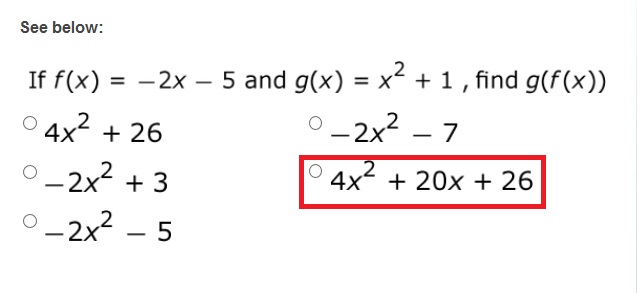
2.
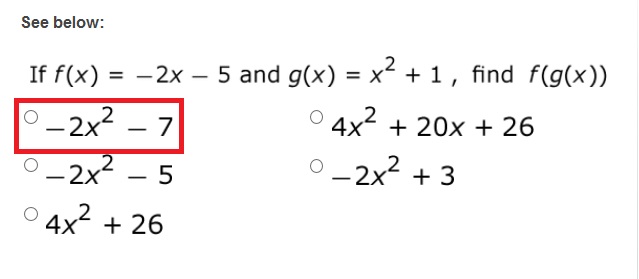
3.
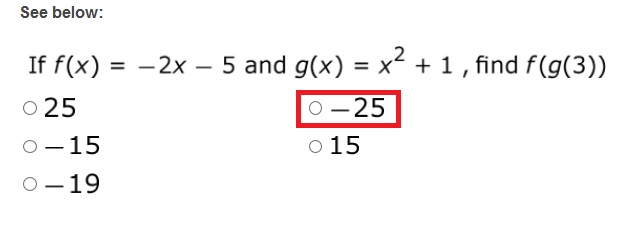
4.
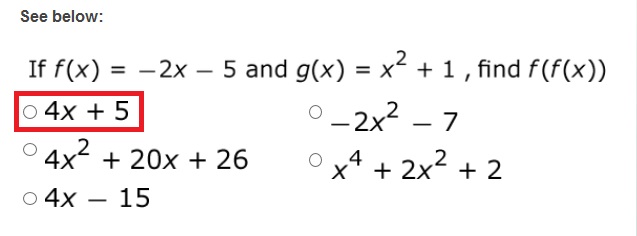
5.

Function composition is the process of putting two or more functions together. This video lesson will explain how this process works and also show you how to evaluate functions that have been composed.
Function Composition
It's really easy for mathematicians to make things seem much harder than they actually are. This often comes down to either confusing vocabulary or confusing notation. While these words or symbols will always have a purpose and will end up making life easier, when you're first learning them it can be hard to keep it all straight.
The topic that this lesson is on, function composition, is one of those topics. It can seem complicated at first, so let's start small and ease you into it.
Function Notation
We'll begin by reviewing what function notation is.
Basically, it's just another way of writing an equation. Instead of saying y = 4x - 1, we can say f(x) = 4x - 1. This notation now gives this function a name, f, and allows us to substitute anything we want into it.
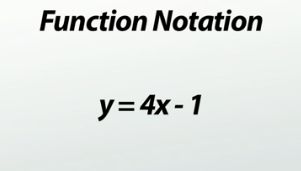 |
Instead of f(x), what if it was f(w)? That means f(w) is just 4w - 1.
We don't just have to use symbols, either. How about f(6)? Now we just put a 6 in that spot: 4(6) - 1 = 23.
We could even use random shapes if we want! How about f(:))? I just plug that smiley face right in, which means f(:)) = 4:) - 1.
Let's up the difficulty a little bit. Instead of substituting in a single term, what if we tried an expression with multiple terms? Maybe f(-2m+3)? Just because it's a bigger expression doesn't mean we do anything different. Where there used to be an x (or a smiley, or a 6, or a w), now I put -2m + 3. That gives us this: 4(-2m + 3) - 1, which we can then simplify with the distributive property and combining like terms to end up with our answer: -8m + 11.
Composition of Functions
So, as you can see, we can substitute any old thing into a function. So, why not another function? That's exactly what a composition of functions is - we take one function and plug it into another one. If we defined another function, let's say g(x) to be 3x^2, we can then evaluate f(g(x)) by doing exactly what we have been doing for the last few minutes and just plug one function into another!
 |
We start with the outside function, f: 4 times something - 1, but everywhere that we would normally have put an x, we now substitute in the function g(x). So instead of 4x - 1, or 4w- 1, or 4 :) - 1, we have 4(g(x)) - 1. But since we know that g(x) is just 3x^2, we can substitute that in as well, which makes f(g(x)) equal to 4(3x^2) - 1. Simplifying again gives us our final answer as 12x^2 - 1.
And that's it! But composing functions can be difficult because seeing all those letters - f and g and x - can be daunting. Even when you get that part, it can be easy to do the problem backwards and substitute the functions into each other the wrong way. So, let's look at an example or two, and see if we can address those two common mistakes and prevent them from happening to you.
Example #1
Let's set up some new functions - maybe r(x) = -x + 1 and s(x) = 2x + 5 - and run through the different ways we could compose them.
How about r(s(x))? Well, r is the outside function, so we start with that: negative something plus 1. But instead of an x, we're substituting in s(x). That turns what we have, -x + 1, into -(2x + 5) + 1. Again, distributing and simplifying gives us r(s(x)) = -2x- 4.
How about the other way: s(r(x))? This time the outside function is s, which means we'll start with 2x + 5, but then substitute the r function where the x used to be. That gives us 2(-x + 1) + 5, and our simplified answer is -2x + 7.
Notice that we get different answers when we compose the functions in different directions. This means that you've got to be careful to not do them in the wrong way. I limit my mistakes by always starting by writing down the outside function, and only then do I think about the inside one.
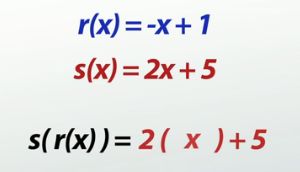 |
Example #2
There are a few other ways to make these problems slightly more complex. One of those is to compose a function with itself. Maybe r(r(x)): r is the outside function, so we start with -x + 1, but then r is the inside function as well, so where we saw the x, we put another -x + 1. That gives us this: -(-x + 1) + 1, which simplifies down to just plain x.
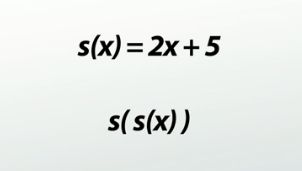 |
We can also evaluate a composition of functions at a specific value - maybe like s(s(3)). We start with the s function, 2x + 5, substitute in another s function, 2(2x + 5) + 5, and then substitute a 3 into that (where the x used to be), giving us 2(2(3) + 5) + 5. Now, instead of just simplifying, we multiply and add it out. 2 times 3 is 6 plus 5 is 11 times 2 is 22 plus 5 is 27. So, s(s(3)) is just 27!
Lesson Summary
Hopefully, this has helped to remove some of the confusing nature of compositions of functions, and show it's simply another way of plugging things into equations. Let's quickly review the highlights.
We can substitute anything we want into a function - variables, shapes, numbers and even other functions!
That's what it means to compose functions - plugging one function into another.
When doing so, begin with the outside function and work your way inside by changing the x into whatever new function you are asked to substitute in.
When evaluating a composition of functions at a specific numeric value, do the same process, but then plug that number in where the x used to be.